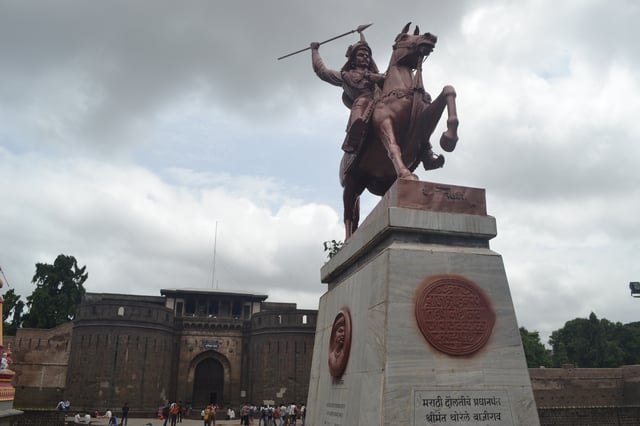Pune

Pune

Pune Poona | |||
|---|---|---|---|
Metropolis | |||
| Nickname(s): | |||
| Coordinates:18°31′13″N 73°51′24″E [277] | |||
| Country | India | ||
| State | Maharashtra | ||
| District | Pune | ||
| Established | 17th Century[3] | ||
| Government | |||
| • Type | Municipal Corporation | ||
| • Body | PMC | ||
| • Municipal Commissioner | Saurabh Rao, IAS[4][5][6] | ||
| • Mayor | Mukta Tilak (BJP)[7][8] | ||
| Area | |||
| • Pune City | 331.26 km2(127.90 sq mi) | ||
| • Metro[11][12] | 7,256.46 km2(2,801.73 sq mi) | ||
| Elevation | 560 m (1,840 ft) | ||
| Population (2011)[13] | |||
| • Pune City | 3,124,458 | ||
| • Rank | 9th | ||
| • Density | 9,400/km2(24,000/sq mi) | ||
| • Metro | 7,276,000[11] | ||
| • Metro Rank | 7th | ||
| Demonym(s) | Punekar,[14] Poonaite[15] | ||
| Time zone | UTC+5:30 (IST) | ||
| PIN Code(s) | 411001 – 411062[16] | ||
| Area code(s) | +91-20 | ||
| Vehicle registration | MH-12[17] | ||
| Member of Parliament | Girish Bapat (BJP)[18][19] | ||
| Languages | Marathi | ||
| Website | pmc.gov.in/en [278] | ||
| Pune population | |||
| Census | Pop. | %± | |
| 1901 | 153,320 | — | |
| 1951 | 488,419 | — | |
| 1971 | 856,105 | — | |
| 1981 | 1,203,351 | 40.6% | |
| 1991 | 1,566,651 | 30.2% | |
| 2001 | 2,540,069 | 62.1% | |
| 2011 | 3,124,458 | 23.0% | |
| Source: Census of India | |||
Pune (Marathi pronunciation: [puɳe]; English: /ˈpuːnə/;[20][21] also called Poona, the official name until 1978),[22][23][24] is the second largest city in the Indian state of Maharashtra, after Mumbai. It is the ninth most populous city in the country with an estimated population of 3.13 million.[25] Along with its extended city limits Pimpri Chinchwad and the three cantonment towns of Pune, Khadki and Dehu Road, Pune forms the urban core of the eponymous Pune Metropolitan Region (PMR).[26] According to the 2011 census, the urban area has a combined population of 5.05 million while the population of the metropolitan region is estimated at 7.27 million.[11] Pune Metropolitan Region along with Mumbai Metropolitan Region and Nashik Metropolitan Region is part of Mumbai Megalopolis also known as Mumbai Megaregion and Golden Triangle of Maharashtra has a population of over 50 millions making this region the most populated urban region in the world.[27][28][29] Situated 560 metres (1,837 feet) above sea level on the Deccan plateau on the right bank of the Mutha river,[30] Pune is also the administrative headquarters of its namesake district. In the 18th century, the city was the seat of the Peshwas, the prime ministers of the Maratha Empire and so was one of the most important political centres on the Indian subcontinent.[31] Pune is ranked the number one city in India in the ease of living ranking index.[32]
The city is considered to be the cultural capital of Maharashtra.[33][34] It is also known as the "Oxford of the East" due to the presence of several well-known educational institutions.[35][36] The city has emerged as a major educational hub in recent decades, with nearly half of the total international students in the country studying in Pune.[37][38] Research institutes of information technology, education, management and training attract students and professionals from India and overseas. Several colleges in Pune have student-exchange programmes with colleges in Europe.[39]
Pune Poona | |||
|---|---|---|---|
Metropolis | |||
| Nickname(s): | |||
| Coordinates:18°31′13″N 73°51′24″E [277] | |||
| Country | India | ||
| State | Maharashtra | ||
| District | Pune | ||
| Established | 17th Century[3] | ||
| Government | |||
| • Type | Municipal Corporation | ||
| • Body | PMC | ||
| • Municipal Commissioner | Saurabh Rao, IAS[4][5][6] | ||
| • Mayor | Mukta Tilak (BJP)[7][8] | ||
| Area | |||
| • Pune City | 331.26 km2(127.90 sq mi) | ||
| • Metro[11][12] | 7,256.46 km2(2,801.73 sq mi) | ||
| Elevation | 560 m (1,840 ft) | ||
| Population (2011)[13] | |||
| • Pune City | 3,124,458 | ||
| • Rank | 9th | ||
| • Density | 9,400/km2(24,000/sq mi) | ||
| • Metro | 7,276,000[11] | ||
| • Metro Rank | 7th | ||
| Demonym(s) | Punekar,[14] Poonaite[15] | ||
| Time zone | UTC+5:30 (IST) | ||
| PIN Code(s) | 411001 – 411062[16] | ||
| Area code(s) | +91-20 | ||
| Vehicle registration | MH-12[17] | ||
| Member of Parliament | Girish Bapat (BJP)[18][19] | ||
| Languages | Marathi | ||
| Website | pmc.gov.in/en [278] | ||
| Pune population | |||
| Census | Pop. | %± | |
| 1901 | 153,320 | — | |
| 1951 | 488,419 | — | |
| 1971 | 856,105 | — | |
| 1981 | 1,203,351 | 40.6% | |
| 1991 | 1,566,651 | 30.2% | |
| 2001 | 2,540,069 | 62.1% | |
| 2011 | 3,124,458 | 23.0% | |
| Source: Census of India | |||
Etymology
History
Early and medieval period

The circular Nandi mandapa at the Pataleshwar cave temple built in the Rashtrakuta era
Copper plates dated 858 and 868 CE show that by the 9th century an agricultural settlement known as Punnaka existed at the location of the modern Pune. The plates indicate that this region was ruled by the Rashtrakuta dynasty. The Pataleshwar rock-cut temple complex was built during this era.[42] Pune was part of the territory ruled by the Seuna Yadavas of Devagiri from the 9th century to 1327.
Bhosale Jagir and the Maratha Empire
Pune was part of the Jagir (fiefdom) granted to Maloji Bhosale in 1599 for his services to the Nizamshahi (Ahmadnagar Sultanate).[43] Pune was ruled by the Ahmadnagar Sultanate until it was annexed by the Mughals in the 17th century. Maloji Bhosale's grandson, Shivaji, the founder of the Maratha Empire, was born at Shivneri, a fort not far from Pune.[44] Pune changed hands several times between the Mughals and the Marathas in the period 1660 to 1705.
After the destruction of the town in raids by the Adil Shahi dynasty in 1630 and again between 1636 and 1647, Dadoji Konddeo, the successor to Dhadphale, oversaw the reconstruction of the town. He stabilised the revenue collection and administrative systems of the areas around Pune and the neighbouring Maval region. He also developed effective methods to manage disputes and to enforce law and order.[45] The Lal Mahal was commissioned in 1631 and construction was completed in 1640 AD.[40] Shivaji spent his young years at the Lal Mahal. His mother, Jijabai is said to have commissioned the building of the Kasba Ganapati temple. The Ganesha idol consecrated at this temple has been regarded as the presiding deity (Gramadevata) of the city.[46]
From 1703 to 1705, towards the end of the 27-year-long Mughal–Maratha Wars, the town was occupied by Aurangzeb and its name was changed to Muhiyabad.[23][47] Two years later the Marathas recaptured Sinhagad fort, and later Pune, from the Mughals.
Peshwa rule
In 1720, Baji Rao I was appointed Peshwa (Prime Minister) of the Maratha Empire by Chhatrapati Shahu.[50] He moved his base from Saswad to Pune in 1728, marking the beginning of the transformation of what was a kasbah into a large city.[51][52] He also commissioned the construction of the Shaniwar Wada on the right bank of the Mutha River. The construction was completed in 1730, ushering in the era of Peshwa control of the city. Bajirao's son and successor, Nanasaheb constructed a lake at Katraj on the outskirts of the city and an underground aqueduct to bring water from the lake to Shaniwar Wada and the city.[53][54] The aqueduct was still in working order in 2004.[55]
The patronage of the Maratha Peshwas resulted in a great expansion of Pune, with the construction of around 250 temples and bridges in the city, including the Lakdi Pul and the temples on Parvati Hill[56] and many Maruti, Vithoba, Vishnu, Mahadeo, Rama, Krishna and Ganesh temples. The building of temples led to religion being responsible for about 15% of the city's economy during this period.[52][57] Pune prospered as a city during the reign of Nanasaheb Peshwa. He developed Saras Baug, Heera Baug, Parvati Hill and new commercial, trading, and residential localities. Sadashiv Peth, Narayan Peth, Rasta Peth and Nana Peth were developed. The Peshwa's influence in India declined after the defeat of Maratha forces at the Battle of Panipat but Pune remained the seat of power. In 1802 Pune was captured by Yashwantrao Holkar in the Battle of Pune, directly precipitating the Second Anglo-Maratha War of 1803–1805. The Peshwa rule ended with the defeat of Peshwa Bajirao II by the British East India Company in 1818.[58]
British rule (1818–1947)
The Third Anglo-Maratha War broke out between the Marathas and the British East India Company in 1817. The Peshwas were defeated at the Battle of Khadki (then spelled Kirkee) on 5 November near Pune and the city was seized by the British. It was placed under the administration of the Bombay Presidency and the British built a large military cantonment to the east of the city (now used by the Indian Army).[59] The Southern Command of the Indian Army was established in 1895 and has its headquarters in Pune cantonment.[60][61][62]
The city was known as Poona during British rule. Poona Municipality was established in 1858. A railway line from Bombay to the city opened in 1858, run by the Great Indian Peninsula Railway (GIPR).[63][64] Navi Peth, Ganj Peth (now renamed Mahatma Phule Peth) were developed during the British Raj.
Centre of social reform and nationalism

British Government House, Ganesh Khind, Poona (c. 1875)
Pune was prominently associated with the struggle for Indian independence. In the period between 1875 and 1910, the city was a centre of agitation led by Gopal Krishna Gokhale and Bal Gangadhar Tilak. The city was also a centre for social reform led by Mahatma Jyotirao Phule, feminist Tarabai Shinde, Dhondo Keshav Karve and Pandita Ramabai. They demanded the abolition of caste prejudice, equal rights for women, harmony between the Hindu and Muslim communities, and better schools for the poor.[65] Mahatma Gandhi was imprisoned at the Yerwada Central Jail several times and placed under house arrest at the Aga Khan Palace between 1942 and 1944, where both his wife Kasturba Gandhi and aide Mahadev Desai died.[66]
Pune since Indian independence

National Chemical Laboratory
After Indian independence from the British in 1947, Pune saw enormous growth transforming it into a modern metropolis. The Poona Municipal Council was reorganized to form the Pune Municipal Corporation (PMC) in 1950.[67] The education sector in the city continued its growth in the post-independence era with the establishment of the University of Poona (now, Savitribai Phule Pune University) in 1949, the National Chemical Laboratory in 1950 and the National Defence Academy in 1955.[68][69][70]
The establishment of Hindustan Antibiotics in 1954 marked the beginning of industrial development in the Hadapsar, Bhosari, and Pimpri areas.[71][72] MIDC provided the necessary infrastructure for new businesses to set up operations.[73] In the 1970s, several engineering companies were set up in the city, allowing it to vie with Chennai.[74][75] In the 1990s, Pune began to attract foreign capital, particularly in the information technology and engineering industries. IT parks were established in Aundh, Viman Nagar, Hinjawadi and Wagholi. As a result, the city saw a huge influx of people to the city due to opportunities offered by the manufacturing, and lately, the software industries.
The breach in the Panshet dam and the resulting flood of 1961 led to severe damage and destruction of housing close to the river banks.[76] The mishap spurred the development of new suburbs and housing complexes.[77] To integrate urban planning, the Pune Metropolitan Region was defined in 1967 covering the area under PMC, the Pimpri-Chinchwad Municipal Corporation, the three cantonments and the surrounding villages.[78]
In 1998 work on the six-lane Mumbai-Pune expressway began; it was completed in 2001.[79] In 2008 the Commonwealth Youth Games took place in Pune, which encouraged development in the northwest region of the city.[80] On 13 February 2010 a bomb exploded at the German Bakery in the upmarket Koregaon Park neighbourhood in eastern Pune, killing 17 and injuring 60.[81][82][83] Evidence suggested that the Indian Mujahadeen group carried out the attack.[84]
Geography
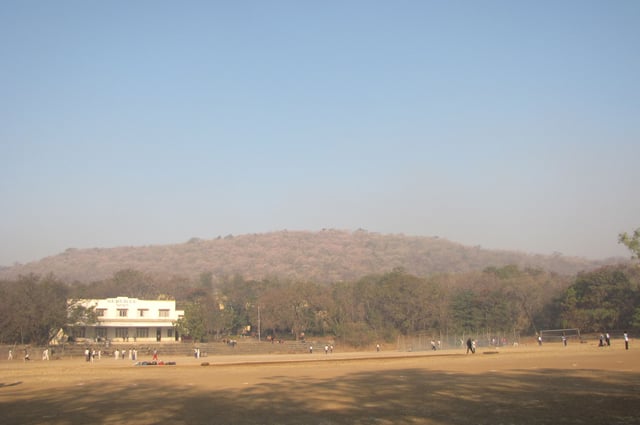
Vetal hill, a prominent hill in Pune. Elevation c. 800 m
Pune lies on the western margin of the Deccan plateau, at an altitude of 560 m (1,840 ft) above sea level. It is on the leeward side of the Sahyadri mountain range, which forms a barrier from the Arabian Sea. It is a hilly city, with Vetal Hill rising to 800 m (2,600 ft) above sea level. The Sinhagad fort is at an altitude of 1,300 metres (4,300 feet).
The old city of Pune is at the confluence of the Mula and Mutha rivers. The Pavana, a tributary of Mula river and Indrayani river, a tributary of the Bhima river, traverse the northwest suburbs of Pune.
Cityscape
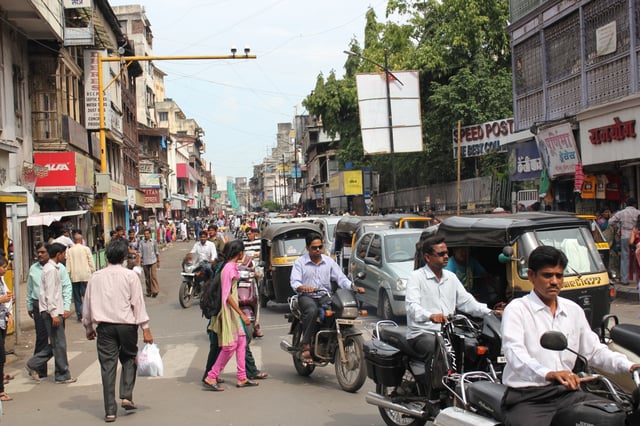
A busy street in Pune, October 2012
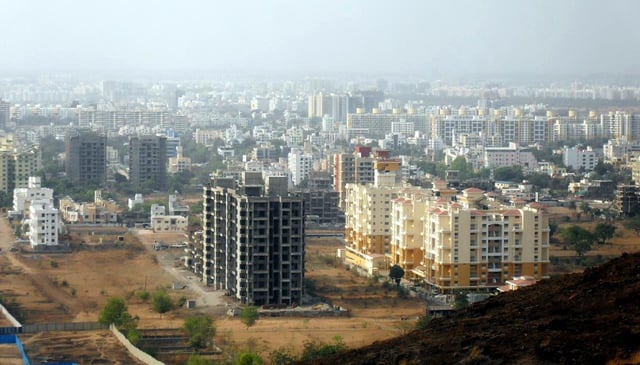
Baner, a recently developed suburb of Pune.

Hadapsar, a recently developed suburb of Pune.
The modern city of Pune has many distinct neighbourhoods. These include the numerous peths of the old city on the eastern bank of the Mutha river, the cantonment areas of Khadki and Pune Camp established by the British, and numerous suburbs.[72] The industrial growth in the Pimpri, Chinchwad and nearby areas allowed these areas to incorporate as the separate city of Pimpri-Chinchwad.[73][86][87][88][89][90][91]
The Pune Metropolitan Region (PMR), initially defined in 1967, has grown to 7,256 km2 made up of the ten talukas of the Pune district.[92] The twin cities of Pune and Pimpri-Chinchwad along with the three cantonment areas of Pune, Khadki and Dehu Road form the urban core of the PMR, which also includes seven municipal councils and 842 villages.[92][93][94]
Rapid industrialisation since the 1960s has led to large influx of people to the city. Housing supply has not kept pace with demand, causing the number of slum dwellings to increase.[95] Approximately 36% of the population lives in 486 slum areas. Of these, 45% slum households do not have in-house toilet facilities and 10% do not have electricity. One third of the slums are on mixed ownership land. The living conditions in slums varies considerably, depending on their status (formal/informal) and in how far non-governmental organizations (NGOs), community organizations (CBOs) and government agencies are involved and committed to improving local living conditions.[96]
Since the 1990s a number of landmark integrated townships and gated communities have been developed in the city such as Magarpatta, Nanded, Amanora, Blue Ridge, Life Republic and Lavasa.[97] They also offer business opportunities and access to infrastructure. According to the PMC, six townships with up to 15,000 housing units existed in Pune in 2012 and 25 more were in the planning process.[96]
The Mercer 2017 Quality of Living Rankings evaluated living conditions in more than 440 cities around the world and ranked Pune at 145, second highest in India after Hyderabad at 144.[98] The same source highlights Pune as being among evolving business centres and as one of nine emerging cities around the world with the citation "Hosts IT and automotive companies".[99] The 2017 Annual Survey of India's City-Systems (ASICS) report, released by the Janaagraha Centre for Citizenship and Democracy, adjudged Pune as the best governed of 23 major cities.[100]
Peths in Pune
Peth is a general term in the Marathi language for a locality in Pune. Seventeen peths are located in Pune, which today constitute the old city of Pune. Most were established during the Maratha empire era under the Maratha and Peshwa rule of the city in the 18th century, before the arrival of the British.[101] Seven of them are named after the days of the week in Marathi, and the day of the week on which traders and craftsmen in these peths mainly conducted business corresponded to the day after which each is named. Other peths are named after their respective founders. Pune includes seventeen peths: Ghorpade Peth, Somwar Peth, Mangalwar Peth, Budhwar Peth, Guruwar Peth, Shukrawar Peth, Shaniwar Peth, Raviwar Peth, Kasba Peth, Bhawani Peth, Ganj Peth, Nana Peth, Ganesh Peth, Sadashiv Peth, Narayan Peth, Rasta Peth, Navi Peth.
Climate
Pune has a hot semi-arid climate (type BSh) bordering with tropical wet and dry (type Aw) with average temperatures ranging between 20 and 28 °C (68 and 82 °F).[102] Pune experiences three seasons: summer, monsoon, and winter. Typical summer months are from mid-March to mid-June, with maximum temperatures sometimes reaching 42 °C (108 °F). The warmest month in Pune is May. The city often has heavy dusty winds in May, with humidity remaining high. Even during the hottest months, the nights are usually cool due to Pune's high altitude. The highest temperature recorded was 43.3 °C (109.9 °F) on 30 April 1897.[103]
The monsoon lasts from June to October, with moderate rainfall and temperatures ranging from 22 to 28 °C (72 to 82 °F). Most of the 722 mm (28.43 in) of annual rainfall in the city falls between June and September, and July is the wettest month of the year. Hailstorms are not unheard of.
For most of December and January the daytime temperature hovers around 26 °C (79 °F) while night temperatures are below 9 °C (48 °F), often dropping to 5 to 6 °C (41 to 43 °F). The lowest temperature recorded was 1.7 °C (35 °F) on 17 January 1935. Due to pollution the city's winter temperature has warmed up by 6 degrees.[104]
| Climate data for Pune | |||||||||||||
|---|---|---|---|---|---|---|---|---|---|---|---|---|---|
| Month | Jan | Feb | Mar | Apr | May | Jun | Jul | Aug | Sep | Oct | Nov | Dec | Year |
| Record high °C (°F) | 35.3 (95.5) | 38.9 (102.0) | 42.8 (109.0) | 45.2 (113.4) | 43.3 (109.9) | 41.7 (107.1) | 36.0 (96.8) | 35.0 (95.0) | 36.1 (97.0) | 37.8 (100.0) | 36.1 (97.0) | 35.0 (95.0) | 45.2 (113.4) |
| Average high °C (°F) | 30.3 (86.5) | 32.8 (91.0) | 36.0 (96.8) | 38.1 (100.6) | 37.2 (99.0) | 32.1 (89.8) | 28.3 (82.9) | 27.5 (81.5) | 29.3 (84.7) | 31.8 (89.2) | 30.5 (86.9) | 29.6 (85.3) | 32.0 (89.6) |
| Daily mean °C (°F) | 20.5 (68.9) | 22.0 (71.6) | 25.6 (78.1) | 28.8 (83.8) | 29.7 (85.5) | 27.4 (81.3) | 25.3 (77.5) | 24.5 (76.1) | 25.1 (77.2) | 25.0 (77.0) | 22.3 (72.1) | 20.2 (68.4) | 24.7 (76.5) |
| Average low °C (°F) | 11.4 (52.5) | 12.7 (54.9) | 16.5 (61.7) | 20.7 (69.3) | 22.5 (72.5) | 22.9 (73.2) | 22.0 (71.6) | 21.4 (70.5) | 20.7 (69.3) | 18.8 (65.8) | 14.7 (58.5) | 12.0 (53.6) | 18.0 (64.4) |
| Record low °C (°F) | 1.7 (35.1) | 3.9 (39.0) | 7.2 (45.0) | 10.6 (51.1) | 13.8 (56.8) | 17.0 (62.6) | 18.9 (66.0) | 17.2 (63.0) | 13.2 (55.8) | 9.4 (48.9) | 4.6 (40.3) | 3.3 (37.9) | 1.7 (35.1) |
| Average precipitation mm (inches) | 0 (0) | 0.5 (0.02) | 5.3 (0.21) | 16.6 (0.65) | 40.6 (1.60) | 116.1 (4.57) | 187.2 (7.37) | 122.3 (4.81) | 120.1 (4.73) | 77.9 (3.07) | 30.2 (1.19) | 4.8 (0.19) | 721.7 (28.41) |
| Average precipitation days | 0.0 | 0.1 | 0.6 | 1.1 | 2.8 | 7.5 | 12.8 | 10.6 | 7.4 | 4.6 | 2.0 | 0.4 | 49.9 |
| Average relative humidity (%) | 56 | 46 | 36 | 36 | 48 | 70 | 79 | 82 | 78 | 64 | 58 | 58 | 59 |
| Mean monthly sunshine hours | 291.4 | 282.8 | 300.7 | 303.0 | 316.2 | 186.0 | 120.9 | 111.6 | 177.0 | 248.0 | 270.0 | 288.3 | 2,895.9 |
| Source #1: Temperature and Precipitation: IMD (1951–1980)[105][106] | |||||||||||||
| Source #2: Sun hours and Humidity: NOAA (1971–1990)[107] | |||||||||||||
Seismology
Pune is 100 km (62 mi) north of the seismically active zone around Koyna Dam.[108][109] The India Meteorological Department has assessed this area as being in Zone 3, on a scale of 2 to 5, with 5 being the most prone to earthquakes.[110][111] Pune has experienced some moderate – and many low – intensity earthquakes in its history.
Demographics
Since Pune is a major industrial metropolis, it has attracted migrants from all parts of India. The number of people migrating to Pune rose from 43,900 in 2001 to 88,200 in 2005.[114] The sharp increase in population during the decade 1991–2001 led to the absorption of 38 fringe villages into the city.[115] The top five source areas of migrants are Karnataka, Uttar Pradesh, Andhra Pradesh, Gujarat, and Rajasthan. The Sindhis in the city are mostly refugees and their descendants, who came to the area after the partition of India in 1947.[116] Initially they settled in the Pimpri area, which is still home to a large number of Sindhi people. However, they are also present in other parts of the city.[117] As agriculture has dwindled in recent decades, immigration of the erstwhile rural peoples now accounts for 70 percent of the population growth.[118][119]
Marathi is the official and most spoken language, while Hindi and Kannada are spoken by a considerable part of the population. The average literacy rate of Pune was 86.15% in 2011 compared to 80.45% in 2001.[120]
Religion
Hinduism is the dominant religion in Pune. Other religions with a significant presence include Islam, Buddhism, Jainism, Christianity and Zoroastrianism.[121]
Of the many Hindu temples in the city, the Parvati temple complex on Parvati Hill and at least 250 others date back to the 18th century.[122] These temples were commissioned by the Peshwas, who ruled the city at the time, and are dedicated to various deities including Maruti, Vithoba, Vishnu, Mahadeo, Rama, Krishna and Ganesh.[123][124][125][126] The historic temples of Kasba Ganapati, the Tambadi (Red) Jogeshwari and the Dulya Maruti are considered the guardian deities of the city.[127][128]Dagdusheth Halwai Ganapati Temple is the richest Ganesh temple in Pune. Pune has two of the most important pilgrimage centres of the Varkari sect of the Bhakti movement in Maharashtra, namely Alandi where the samadhi of 13th century Saint Dnyaneshwar is located and Dehu where the 17th century Saint Tukaram lived. Every year in the Hindu month of Ashadh (June/July), the Paduka (symbolic sandals) of these saints are carried in a pilgrimage, the Pandharpur Vari, to meet Vithoba. The procession makes a stopover in the city on its way to Pandharpur attracting hundreds of thousands of Varkaris and devotees. Other important Hindu pilgrimage sites in PMR or the district include Jejuri, and five of Ashtavinayak Ganesh temples. The Shrutisagar Ashram houses the Vedanta Research Centre and a unique temple of Dakshinamurthy.
Prominent mosques include Chand Tara Masjid, Jama Masjid, and Azam Campus Masjid. Chand Tara Masjid, located in Nana Peth, is one of the biggest and most important mosques in Pune as it is the city headquarters (markaz) for the Tablighi Jamaat. Pune is also the birthplace of Meher Baba, although his followers usually travel to Meherabad to visit his tomb. Hazrat Babajan, identified by Meher Baba as one of the five perfect masters, has a shrine (Dargah) erected in her honour under a neem tree in Pune Camp.[129][130]
The city has several churches dedicated to different Christian denominations including St. Anthony's Shrine, Dapodi Church, etc. St. Patrick's Cathedral built in 1850 is the seat of the bishop of the Roman Catholic Diocese of Poona. Pune has Jain temples dating back to the Peshwa era. At present, there are more than one hundred Jain temples in PMR with the one at Katraj being the largest.[131] Pune has over 20 Gurdwaras, with Gurdwara Guru Nanak Darbar in Pune Camp and Gurdwara Shri Guru Singh Sabha in Ganesh Peth being the ones situated in the heart of the city. The 19th-century Ohel David Synagogue, known locally as Lal Deval, is said to be one of the largest synagogues in Asia outside Israel.[132][133] The Sir Jamsetjee Jejeebhoy Agiary is a prominent Zoroastrian temple.
Pune has been associated with several significant recent spiritual teachers. The controversial Guru Osho, formerly the self-styled Bhagwan Rajneesh, lived and taught in Pune for much of the 1970s and 1980s. The Osho International Meditation Resort, one of the world's largest spiritual centres, is located in Koregaon Park and attracts visitors from over a hundred countries. The meditation resort organizes music and meditation festival every year during monsoon, known as Osho Monsoon Festival. Number of well known artists around the world participates in the event.[134]
Economy

Volkswagen India Plant and offices in Pune
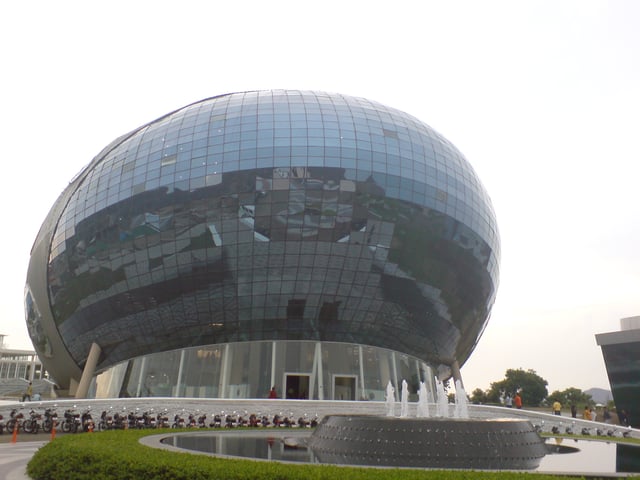
Infosys Pune
Pune has the eighth largest metropolitan economy and the sixth highest per capita income in the country.[135][136] The key sectors of the local economy are education, manufacturing and information technology (IT).
The Kirloskar Group came to Pune in 1945 by setting up Kirloskar Oil Engines, India's largest diesel engine company, at Khadki.[140][141] The group has several subsidiaries in Pune including Kirloskar Pneumatics and Kirloskar Brothers Limited, one of India's largest manufacturers and exporters of pumps and the largest infrastructure pumping project contractor in Asia.[142][143] Automotive companies such as Bajaj Auto, Tata Motors, Mahindra & Mahindra, Mercedes Benz, Force Motors, Kinetic Motors, General Motors, Land Rover, Jaguar, Renault, Volkswagen, and Fiat have set up greenfield facilities near Pune, leading The Independent to describe Pune as India's "Motor City".[144] According to the Indo-German Chamber of Commerce, Pune has been the single largest hub for German companies for the last 60 years. Over 225 German companies have set up their businesses in Pune.[145][146] Serum Institute of India, the world's fifth largest vaccine producer by volume, has a manufacturing plant located in Pune.[147] In 2014-15, the manufacturing sector provided employment to over 500,000 people.[148]
The Rajiv Gandhi Infotech Park in Hinjawadi is a ₹600-billion (US$8.9 billion) project by the Maharashtra Industrial Development Corporation (MIDC).[149][150] The IT Park encompasses an area of about 2,800 acres (11 km2) and is home to over 800 IT companies of all sizes.[151][148] Besides Hinjawadi, IT companies are also located at Magarpatta, Kharadi and several other parts of the city. As of 2017, the IT sector employs more than 300,000 people.[151][148]
Pune has also emerged as a new hub for tech startups in India.[152][153][154] NASSCOM, in association with MIDC, has started a co-working space for city based startups under its 10,000 startups initiative at Kharadi MIDC.[155] Pune Food Cluster development project is an initiative funded by the World Bank. It is being implemented with the help of Small Industries Development Bank of India, Cluster Craft to facilitate the development of the fruit and vegetable processing industries in and around Pune.[156][157]
The Meetings, Incentives, Conferencing, Exhibitions trade is expected to be boosted since the Pune International Exhibition and Convention Centre (PIECC) opened in 2017. The 97-hectare PIECC boasts a seating capacity of 20,000 with a floor area of 13,000 m2 (139,931 sq ft). It has seven exhibition centres, a convention centre, a golf course, a five-star hotel, a business complex, shopping malls, and residences. The US$115 million project was developed by the Pimpri-Chinchwad New Town Development Authority.[158]
Companies headquartered in Pune
The following is a list of some companies that have their global or national headquarters in Pune or the surrounding area.
Culture
Architecture
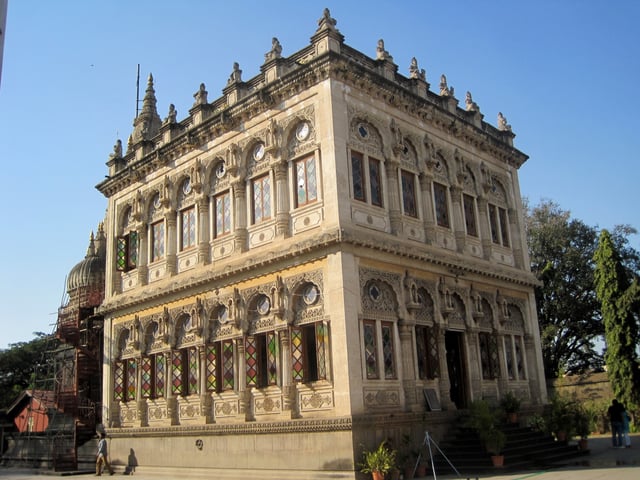
Shinde Chhatri in Wanowrie, Pune.
Historical attractions include the rock-cut Pataleshwar cave temple, Aga Khan Palace, Shaniwarwada, Lal Mahal and Sinhagad fort. Shinde Chhatri, located at Wanowrie, is a memorial dedicated to the great Maratha sardar, Mahadaji Shinde (Scindia).[159] The city is also known for its British Raj bungalow architecture and the Garden Cities Movement layout of the Cantonment from the early 20th century. Landmark architectural works by Christopher Charles Benninger surround the city, including the Mahindra United World College of India, the Centre for Development Studies and Activities, the YMCA Retreat at Nilshi and the Samundra Institute of Maritime Studies.
Museums, parks and zoos
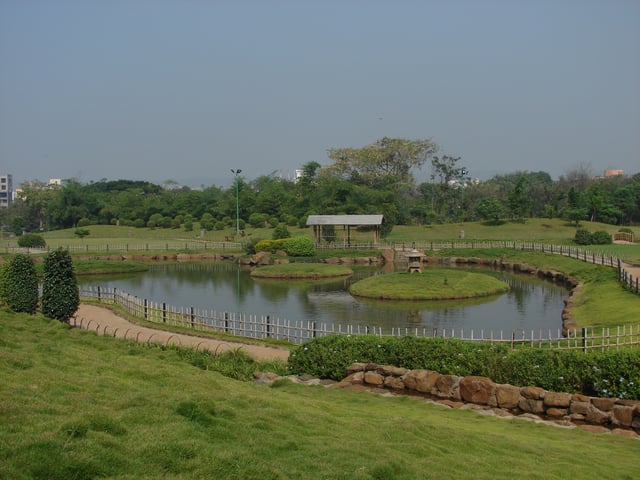
Pu. La. Deshpande Garden
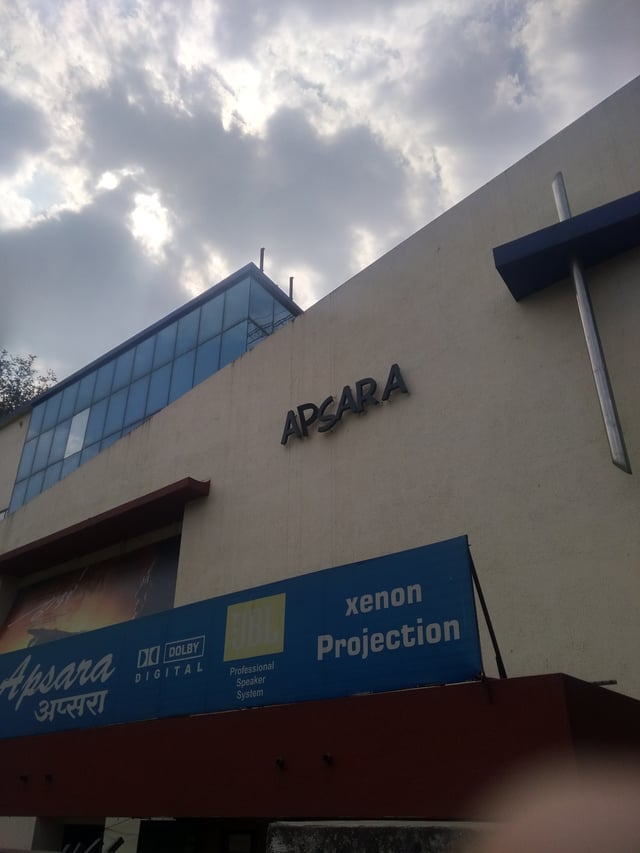
Apsara Theater
Museums in Pune include the Raja Dinkar Kelkar Museum, Mahatma Phule Industrial Museum, Dr. Babasaheb Ambedkar Museum, Joshi's Museum of Miniature Railway and the Pune Tribal Museum. Pune also houses Blades of Glory Cricket Museum which is the biggest cricket museum in the world. The College of Military Engineering has an archive and an equipment museum; this includes a rail exhibit with a metre-gauge train.The Aga Khan Palace, where Mahatma Gandhi was interned during the Quit India movement, has a memorial dedicated to his wife, Kasturba Gandhi who died here during the internment. Chhatrapati Shivaji Maharaj Museum of Indian History,a private museum built by Frenchman Francois Gautier opened its first phase in 2012.
Parks and green spaces in the city include the Kamala Nehru Park, Sambhaji Park, Shahu Udyan, Peshwe Park, Saras Baug, Empress Gardens, and Bund Garden . The Pu La Deshpande Udyan is a replica of the Korakuen Garden in Okayama, Japan.[160] The Hanuman hill, Vetal hill, and Taljai Hills are protected nature reserves on hills within the city limits.
The Rajiv Gandhi Zoological Park is located in Katraj.[161] The zoo, earlier located at Peshwe Park, was merged with the reptile park at Katraj in 1999.
Performing arts
Ganesh Kala Krida Rangamanch is the largest indoor theatre in the city, with a seating capacity of approximately 45,000.[165] The Sawai Gandharva Sangeet Mahotsav, one of the most prominent and sought-after Indian classical music festivals in India, is held in Pune every year in December. It commemorates the life and achievements of Sawai Gandharva.[166] The concept of Diwāḷī Pahāṭ (lit. Diwali dawn) originated in Pune as a music festival on the morning of the festival of Diwali.[167]
Sport
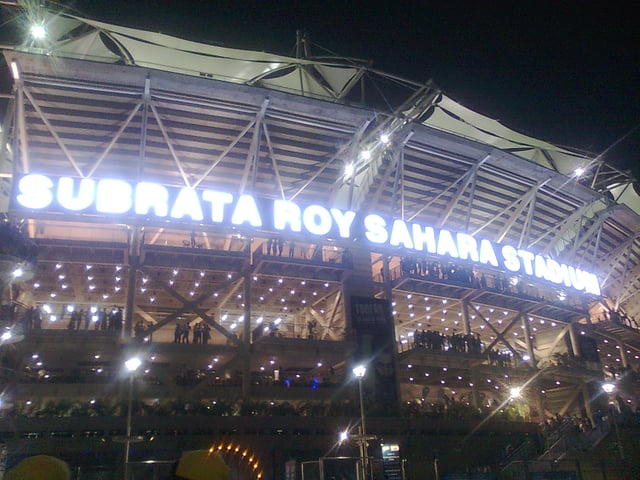
Maharashtra Cricket Association Stadium
As a matter of historic interest, early on, the game of badminton was also known as Poona or Poonah after the then British garrison town of Poona where it was particularly popular and where the first rules for the game were drawn up in 1873. (Games employing shuttlecocks have been played for centuries across Eurasia, but the modern game of badminton developed in the mid-19th century among the British as a variant of the earlier game of battledore and shuttlecock. "Battledore" was an older term for "racquet".)[168][169]
Popular games and sports in Pune include athletics, cricket, basketball, badminton, field hockey, football, tennis, kabaddi, paragliding, kho-kho, rowing, and chess. The Chhatrapati Shivaji Stadium in Balewadi is the venue for wrestling and other traditional sports. The Royal Connaught Boat Club is one of several boating clubs on the Mula-Mutha river. Pune has basketball courts at the Deccan Gymkhana and at Fergusson College.[170] Pune Skatepark is a skateboarding park built in Sahakarnagar, consisting of an eight-foot bowl in a 3,000 square foot flatground.[171] Other prominent sporting institutions in Pune include the Nehru Stadium, the PYC Hindu Gymkhana, the Poona Golf Club and the Poona Cricket Club.
The Pune International Marathon is an annual marathon conducted in Pune. The National Games of 1994 and the 2008 Commonwealth Youth Games were held in the city at the Balewadi Stadium. The Deccan Gymkhana has hosted Davis Cup matches on several occasions. The 37,000 seating capacity Maharashtra Cricket Association Stadium has hosted international cricket – T20s, One Day Internationals, and a test match.[172] The National Education Foundation organises Enduro3, a cross country adventure race in Pune. It is a two- or three-day event with activities including cycling, trekking, river-crossing and rifle shooting.[173] Pune Race Course was built in 1830 on 118.5 acres (0.480 km2) of land and is managed by the Royal Western India Turf Club. The course has two training tracks and two racing surfaces. The racing season is from July to October every year and includes major racing events the Pune Derby, the RWITC Invitational, the Independence Cup and the Southern Command Cup.[174] The city has also hosted the 2009 FIVB Men's Junior World Championship.
Teams
The Maharashtra cricket team, one of the three teams of the Maharashtra Cricket Association that compete in interstate matches and leagues such as the Ranji Trophy, is based in the city. Pune Warriors India (2011-2014) and Rising Pune Supergiant (2016-2017) were the two teams based in Pune to play in the Indian Premier League.[175] Poona District Football Association (PDFA) was established in 1972 and currently has more than 100 registered teams.[176] FC Pune City is an Indian Super League football club in Pune. Established in 2014, FC Pune City became the only professional football club in India to have teams which participated at all levels of professional football; Senior Team (ISL), U-18 Team (I-League U-18), U- 16 Team, U-14 Team and the Women's Team.[177] The city is home to the Pune Peshwas, runners-up in the 2015 UBA Pro Basketball League season. Pune also has an American football franchise, called the Pune Marathas, which began playing in the inaugural season of the Elite Football League of India in 2011 and which plays at the Balewadi Stadium.[178][179]
Government and public services
Civic administration
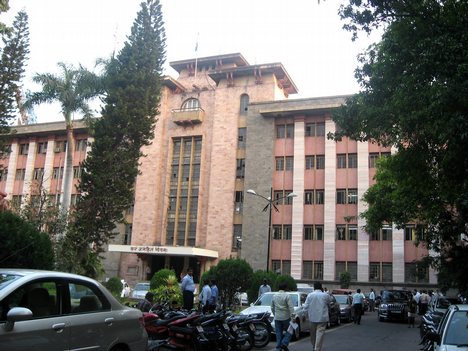
Pune Municipal Corporation Building
Pune Municipal Corporation (PMC) is the civic body responsible for local government. It comprises two branches, the executive branch headed by the Municipal Commissioner, an IAS officer appointed by the Government of Maharashtra, and an elected deliberative branch, the general body, headed by the Mayor of Pune.[180] Municipal elections are held every five years to elect councillors, commonly known as "corporators", who form the general body. The current general body of the PMC elected in February 2017 has 162 corporators representing 41 wards (39 with 4 corporators each and 2 with 3 each).[181] The general body, in turn, elects the mayor and the deputy mayor. The mayor has a ceremonial role as the first citizen and ambassador of the city while the actual executive power lies with the municipal commissioner. For policy deliberations, corporators form several committees. Perhaps the most important of these is the 16-member Standing Committee, half of whose members retire every year.[182] The Standing Committee and the 15 ward committees are in charge of financial approvals.[180] PMC was ranked 8th out of 21 Indian cities for best governance and administrative practices in 2014. It scored 3.5 out of 10 compared to the national average of 3.3.[183]
The Pune City Police Department is the law enforcement agency for the twin cities of Pune and Pimpri-Chinchwad. It is a division of the Maharashtra Police and is headed by the Police Commissioner, an officer of the Indian Police Service. The Pune Police Department reports to the State Ministry of Home Affairs. A separate police commissionerate was announced for Pimpri-Chinchwad in April 2018 to be carved out of Pune Police Department.[184][185] The new commissionerate will take charge on 15 August 2018.[186][187]
Pune Metropolitan Region Development Authority (PMRDA) was formed on 31 March 2015 and is responsible for the integrated development of the PMR.[188] Currently its jurisdiction extends over 7,256.46 km2 (2,802 sq mi) and includes two municipal corporations, three cantonment boards, seven municipal councils, 13 census towns and 842 villages.[92][94]
Utility services
The PMC supplies the city with potable water that is sourced from the Khadakwasla Reservoir. There are five other reservoirs in the area that supply water to the city and the greater metropolitan area.[189]
The city lacks the capacity to treat all the sewage it generates, which leads to the Mutha river containing only sewage outside the monsoon months.[190] In 2009 only 65% of sewage generated was treated before being discharged into the rivers.[189] PMC is also responsible for collecting solid waste. Around 1,600 tons of solid waste is generated in Pune each day. The waste consists of 53% organic, compostable material; and 47% inorganic material, of which around half is recyclable. The unrecovered solid waste is transported to the dumping grounds in Urali devachi.[191]
The state owned Maharashtra State Electricity Distribution Company Limited supplies electricity to the city. Bharat Sanchar Nigam Limited (BSNL), owned by the central government, as well as private enterprises such as Vodafone, Bharti Airtel, Reliance, Idea Cellular, Tata DoCoMo, Tata Teleservices, and Virgin Mobile, are the leading telephone and cell phone service providers in the city.[192] [] []
Education and research
Pune has over a hundred educational institutes and more than nine deemed universities apart from the Savitribai Phule Pune University (SPPU; formerly University of Pune), which is the second largest University in the country based on total number of affiliated colleges.[193] Higher education institutes attract international students mainly from the Middle Eastern countries such as Iran, and United Arab Emirates, and also African countries such as Ethiopia and Kenya.[194] Pune is the largest centre for Japanese learning in India.[195] Other languages taught in the city include German, which is taught at the Goethe-Institut, and French, which is taught at Alliance Française.
Basic education
The PMC runs 297 primary schools and 30 secondary and higher secondary schools.[196][197] While it is mandatory for the PMC to provide primary education under state law, secondary education is an optional duty.[197][198][199] In the rural and suburban areas of the PMR, public primary schools are run by the Pune Zilla Parishad. Private schools are run by education trusts and are required to undergo mandatory inspection by the concerned authorities. Private schools are eligible for financial aid from the state government.[200] Public schools are affiliated to the Maharashtra State Board of Secondary and Higher Secondary Education (State Board). The language of instruction in public schools is primarily Marathi, although the PMC also runs Urdu, English and Kannada medium schools.[197][201][202] Along with these languages, private schools also offer instruction in Hindi and Gujarati.[203] Private schools vary in their choice of curriculum and may follow the State Board or one of the two central boards of education, the CBSE or CISCE.[204][205]
University education

Savitribai Phule Pune University headquarters. During the British era, the building served as the Monsoon residence for the Governor of the Bombay Presidency
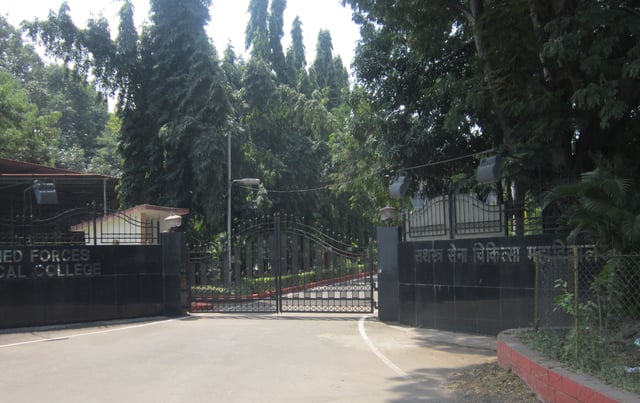
Armed Forces Medical College, Pune
Most colleges in Pune are affiliated to the SPPU (Savitribai Phule Pune University). Nine other universities have also been established in the city.[206] Pune also hosts the Military Intelligence Training School which offers diploma courses in counter intelligence, combat intelligence, aerial imagery and interpretation, among others.[207]
The College of Engineering Pune, an autonomous institute of the government of Maharashtra founded in 1854, is the third oldest engineering college in Asia. The Deccan Education Society was founded by local citizens in 1884, including social and political activist Bal Gangadhar Tilak, who was also responsible for founding Fergusson College in 1885.[208] The Indian Law Society's (ILS) Law College is one of the top ten law schools in India.[209] The Armed Forces Medical College (AFMC) and B. J. Medical College are among the top medical colleges in India. The AFMC consistently ranks among the top five medical colleges in India.[210] The Film and Television Institute of India, one of only three Indian institutions in the global CILECT film school network, is located on Law College Road. The Lalit Kala Kendra is an undergraduate department of Music, Dance and Drama on the SPPU campus that has been operational since 1987. This department features a combination of gurukul and formal education systems.[211]
Symbiosis International University operates 33 colleges and institutions in the city, including the Symbiosis Institute of Business Management, the Symbiosis Institute of Management Studies, the Symbiosis Centre for Management and Human Resource Development, the Symbiosis Law School and the Symbiosis Institute of International Business. They are ranked among the top management and law institutes in the country.[212][213] The Symbiosis Institute of Computer Studies and Research is one of the few colleges in India that promotes open source technology.[214]
Research Institutes
Pune is home to a number of governmental and non-governmental research institutes focusing on a wide range of subject areas from the humanities to the sciences. The Ministry of Defence also runs a number of defence related education, training and research establishments in and around the city. Major research centers include:
Agharkar Research Institute (ARI)
Armament Research Development Establishment (ARDE)
Army Institute of Technology (AIT)
Automotive Research Association of India (ARAI)
Bhandarkar Oriental Research Institute (BORI)
Central Institute of Road Transport (CIRT)[215]
Central Water and Power Research Station (CW&PRS)
Centre for Development of Advanced Computing (C-DAC)[216]
Defence Research and Development Organisation (DRDO)
Defence Institute of Advanced Technology (DIAT)[217]
National Defence Academy (NDA)
Gokhale Institute of Politics and Economics
High Energy Materials Research Laboratory (HEMRL)
Indian Institute of Science Education and Research, Pune (IISER, Pune)
Indian Institute of Tropical Meteorology (IITM) – scientists at IITM has made significant achievements in tropical weather[218]
Inter-university Centre for Astronomy & Astrophysics (IUCAA)
National Centre for Cell Science (NCCS)
National Centre for Radio Astrophysics (NCRA)
National Chemical Laboratory (NCL) – one of the leading chemical research establishments in India
National Informatics Centre (NIC)
National Institute of Bank Management (NIBM)
National Institute of Construction Management and Research (NICMAR) – India's most reputed institute for Construction Management
National Institute of Virology (NIV)
National School of Leadership (NSL)
National Insurance Academy (NIA)
Tata Research Development and Design Centre (TRDDC)
National AIDS Research Institute(NARI)
Media
A number of Marathi-language newspapers from the British era continued publishing decades after independence. These included Kesari, Tarun Bharat, Prabhat and the politically neutral Sakal.[219] Sakal has remained the most popular Marathi daily.[220][221] Kesari is now only published as an online newspaper. Mumbai based Maharashtra Times, Loksatta and Lokmat have all introduced Pune based editions in the last fifteen years. The Mumbai-based popular English newspaper the Indian Express has a Pune edition. Its rival the Times of India introduced a tabloid called Pune Mirror in 2008. Mid Day, Daily News and Analysis and Sakaal Times are other local English newspapers. The English-language newspaper The Hindu has launched a Pune edition covering local as well as national news.
The government owned All India Radio (AIR) has been broadcasting from Pune since 1953.[222] Savitribai Phule Pune University broadcasts programmes focusing on its different departments and student welfare schemes on its own FM radio channel called Vidyavani.[223] A number of commercial FM channels are also received in the city.[224] The city receives almost all of the television channels in India including broadcast, cable and direct-to-home TV.
Transport
Public transport

Pune Railway Station – entrance

An EMU on the Pune-Lonavla suburban line
Public transport in Pune includes Pune Suburban Railway, bus services operated by PMPML and auto rickshaws. Online transport network companies such as Uber and Ola Cabs also provide rideshare and taxi services in the city. Construction of Pune Metro, an urban mass rapid transit system, is underway as of 2018.[225]
Rail
Pune Suburban Railway (electric multiple units) (popularly called local trains) connect Pune to the industrial city of Pimpri-Chinchwad and the hill station of Lonavala. Daily express trains connect Pune to Mumbai, Nashik, Ahmedabad, Chennai, Delhi, Hyderabad, Jaipur, Nagpur, Thiruvananthapuram, Kochi, Coimbatore, Bangalore, Allahabad, Kanpur, Howrah, Jammu Tawi, Darbhanga, Goa, Gwalior, Varanasi, Bhubaneswar, Ranchi, Patna, and Jamshedpur. At Pune, there is a diesel locomotive shed and an electric trip shed.[226] Pune Railway Station is administered by the Pune Railway Division of Central Railways.[227]
Bus service

Local buses in Pune
Public buses within the city and its suburbs are operated by Pune Mahanagar Parivahan Mahamandal Limited (PMPML). PMPML operates the Rainbow BRTS system, the first of its kind in India, in which dedicated bus lanes were supposed to allow buses to travel quickly through the city. The project has turned out to be a failure, receiving little patronage from the local citizenry.[228] Maharashtra State Road Transport Corporation runs buses from stations in Shivajinagar, Pune station, and Swargate to all major cities and towns in Maharashtra and neighbouring states. Private companies also run buses to major cities throughout India.[229]
Metro
Pune Metro, a mass rapid transit system, is under construction and is expected to be operational by 2021.[230][231] The detailed project report was prepared for the initial two lines by Delhi Metro Rail Corporation which was approved by the State government in 2012 and by the central government in December 2016.[232][233][234] Two lines, Line 1 from Pimpri Chinchwad Muncipal Corportion Building to Swargate and Line 2 from Ramwadi to Vanaz, with a combined length of 31.25 kilometres (19.42 mi), are being constructed by MahaMetro, a 50:50 joint venture of the State and central governments.[235] Line 1 will run underground between Swargate and Range Hills be and elevated until Pimpri Chinchwad. Line 2 will be completely elevated and will intersect Line 1 at the Civil Court interchange station in Shivajinagar.[236]
Road transport
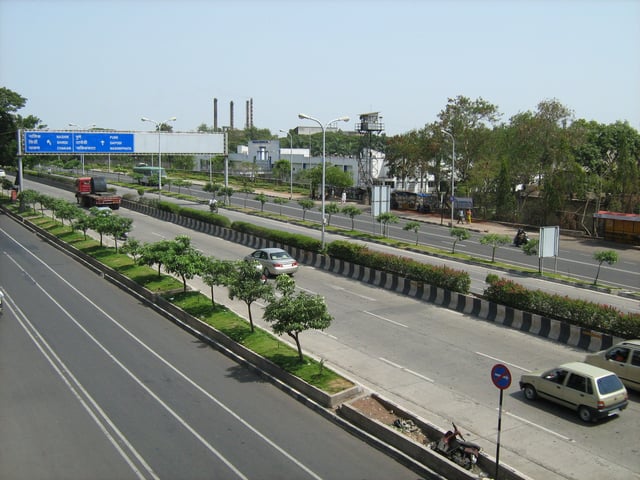
A highway leading into Pune
Pune is well-connected to other cities by Indian and state highways. National Highway 4 connects it to Mumbai, Bangalore and Kolhapur. National Highway 65 to Hyderabad, Suryapet, Vijayawada and National Highway 50 to Nashik. State highways connect Pune to Ahmednagar, Aurangabad and Alandi. Pune is served by three intra-city highways: Old Mumbai–Pune Highway; Pune–Satara Highway and Dehu Road–Katraj bypass, all part of National Highway 4.
Personal transport

Two wheelers in Pune
Once known as the "cycle city of India", Pune has experienced a rapid growth in the number of motorised two wheelers replacing the bicycle.[243] In 2005 the city was reported to have one million two wheelers. The report also stated that the increase in vehicular and industrial activity had led to a 10-fold increase in particulate pollution in some areas of the city.[244] A report published in 2016 estimated the number of two wheeler users in Pune at 3.5 million.[245] In 2018 the number of vehicles in the city has exceeded its population with 3.62 million total vehicles, 2.70 million being two wheelers.[246][247] In the fiscal year 2017–18 alone 300,000 new vehicles were registered in the city, two-thirds of them two wheelers.[248]
A revival of cycling in Pune with 130 kilometres (81 mi) of cycle tracks built was attempted as a part of the BRT system under the Jawaharlal Nehru National Urban Renewal Mission in 2004. However, a 2011 report revealed that only 88 kilometres (55 mi) of tracks were actually built and most were unusable at the time of the report.[249][250] Under the Smart Cities Mission, app based cycle sharing schemes have been launched in the city since late 2017.[251][252][253] The PMC has devised the Pune Cycle Plan with 470 kilometres (290 mi) of cycle tracks planned.[254][255][256] Cycles are also seen as a possible way of improving last mile connectivity for the metro system.[257]
Air

Departure lounge at Pune Airport
Pune International Airport is an international Airport at Lohegaon, operated by the Airports Authority of India. It shares its runways with the neighbouring Indian Air Force base.[258] In addition to domestic flights to all major Indian cities, the airport has international direct flights to Dubai, operated by Air India Express,[259] and SpiceJet.
A new international airport has been proposed, due to the limited capacity of the existing airport. A location in the Chakan-Rajgurunagar area was chosen for the airport,[260][261] but non-availability of land delayed the project for over a decade.[262] In September 2016 the location was changed to Purandar, c. 20 kilometres (12 mi) south of the city.[263][264]
Healthcare
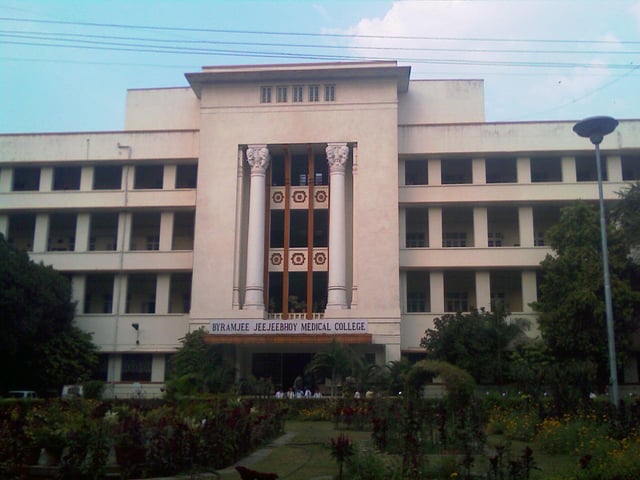
B. J. Medical College, Pune was established in 1878 and is associated with the Sassoon Hospital.
Healthcare in the PMR is provided by private and public facilities. Primary care is provided by practitioners of western as well as traditional alternative medicine (i.e.Ayurved, Homeopathy and Unani). For minor and chronic ailments, people in the region have preference for practitioners of the traditional medicine.[265]
The PMR is served by three government hospitals: Sassoon Hospital, Budhrani and Dr Ambedkar Hospital. There are also a number of private hospitals such as Ranka Hospital, Sahyadri, Jahangir Nursing Home, Sancheti Hospital, Aditya Birla Memorial Hospital, KEM Hospital, Ruby Hall and Dinanath Mangeshkar Hospital.
International relations
- Twin towns and sister cities
[[INLINE_IMAGE|//upload.wikimedia.org/wikipedia/en/thumb/a/a4/Flag_of_the_United_States.svg/23px-Flag_of_the_United_States.svg.png|//upload.wikimedia.org/wikipedia/en/thumb/a/a4/Flag_of_the_United_States.svg/35px-Flag_of_the_United_States.svg.png 1.5x, //upload.wikimedia.org/wikipedia/en/thumb/a/a4/Flag_of_the_United_States.svg/46px-Flag_of_the_United_States.svg.png 2x|United States|h12|w23|thumbborder flagicon-img flagicon-img]] San José, California, United States (1992)[268][269]
[[INLINE_IMAGE|//upload.wikimedia.org/wikipedia/commons/thumb/7/77/Flag_of_Mauritius.svg/23px-Flag_of_Mauritius.svg.png|//upload.wikimedia.org/wikipedia/commons/thumb/7/77/Flag_of_Mauritius.svg/35px-Flag_of_Mauritius.svg.png 1.5x, //upload.wikimedia.org/wikipedia/commons/thumb/7/77/Flag_of_Mauritius.svg/45px-Flag_of_Mauritius.svg.png 2x|Mauritius|h15|w23|thumbborder flagicon-img flagicon-img]] Vacoas-Phoenix, Mauritius[270]
Austin, Texas, United States – since 2018
Informal relationship
[[INLINE_IMAGE|//upload.wikimedia.org/wikipedia/en/thumb/b/ba/Flag_of_Germany.svg/23px-Flag_of_Germany.svg.png|//upload.wikimedia.org/wikipedia/en/thumb/b/ba/Flag_of_Germany.svg/35px-Flag_of_Germany.svg.png 1.5x, //upload.wikimedia.org/wikipedia/en/thumb/b/ba/Flag_of_Germany.svg/46px-Flag_of_Germany.svg.png 2x|Germany|h14|w23|thumbborder flagicon-img flagicon-img]] Bremen, Germany[271][272][273]
See also
List of people from Pune
List of tourist attractions in Pune
Pune Mahanagar Parivahan Mahamandal Limited
Pune Metro
Chhatrapati Sambhaji Raje International Airport



